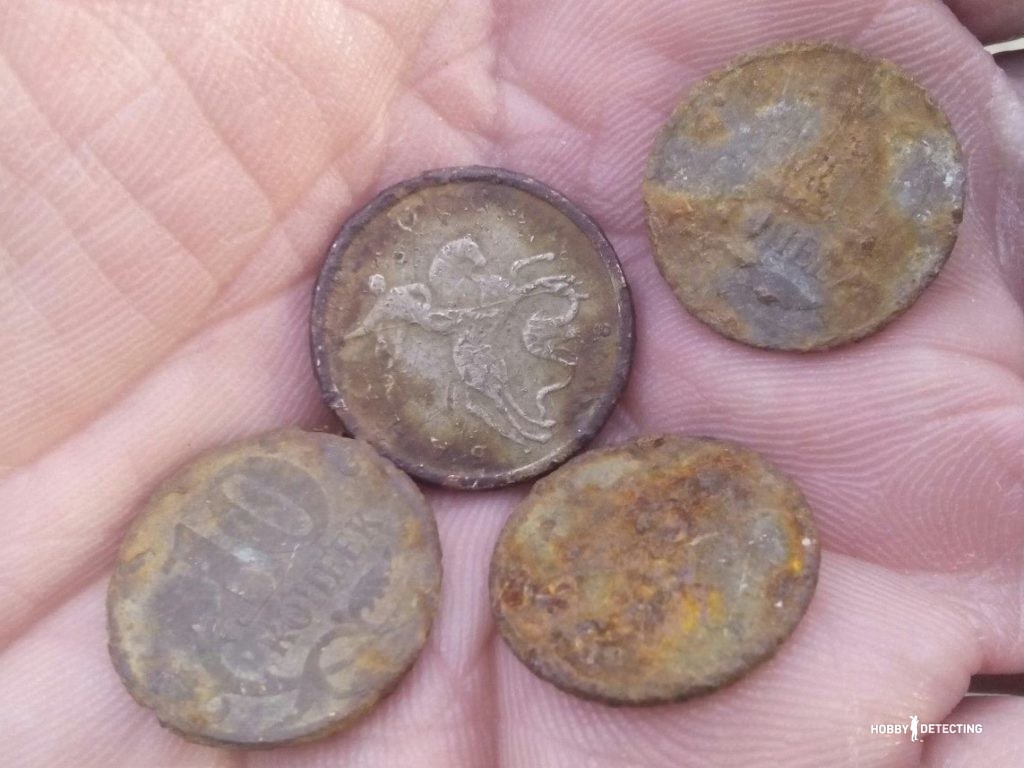What mark will modern Bank of Russia coins leave in numismatics?
The other day, a friend wrote to me on a social network saying that, while recently walking along the beach with a metal detector, he found several modern coins in terrible condition. Moreover, the Soviet coin found on the same day, which had lain in the sand for more than 20 years, looked simply perfect.
Of course, we talked about this topic and sadly stated the fact that in our time, Russian coins, unfortunately, literally rot within a year, ending up in the ground or sand.
 Indeed, in the past, coins were made to last for centuries, but now you can no longer look at a modern coin that has lain in the ground (sand) for at least one year without tears… The fact is that modern coins deteriorate so quickly due to the method of production , namely, galvanizing (steel coated with nickel or brass), and this is done because of savings, since the state is forced to spend at least 70 kopecks on the production of, for example, 5 kopecks.
Indeed, in the past, coins were made to last for centuries, but now you can no longer look at a modern coin that has lain in the ground (sand) for at least one year without tears… The fact is that modern coins deteriorate so quickly due to the method of production , namely, galvanizing (steel coated with nickel or brass), and this is done because of savings, since the state is forced to spend at least 70 kopecks on the production of, for example, 5 kopecks.
In fact, many people today don't even realize that they are literally wasting money. For example, when leaving the store, they throw away all the small things they received as change – up to 50 kopecks, and sometimes with a higher denomination!!!
It seems to me that coins (even the smallest denominations) still deserve respect. I usually always pick up any coin that happens to be under my feet, but this is not out of greed, but out of a desire to save it and return it to active life.
However, despite all the extravagance of modern people, our children, grandchildren, as well as even more distant generations, these coins WILL NOT RECEIVE from the ground in good preservation. And this is very sad… Yes, today they cost almost nothing (although some are already worth tens of thousands of rubles), but in 100 years our descendants could be offered quite a good amount of money for them.
Seeing rusty modern coins, you understand that these coins will soon simply rot, leaving no trace for Russian numismatics!
And the saddest thing is that not only modern walking clothes rust, but even investment coins made of gold and silver!
In 2010, a huge scandal occurred between millionaire German Sterligov and the Bank of Russia. The essence of the matter was that the above-mentioned businessman purchased several thousand investment gold coins “Victorious” of 999 standard (the cost of each coin was 10,000 rubles). A significant part of these coins were not stored in safe deposit boxes, but were buried by German Sterligov under an oak tree on his estate.
What a surprise the businessman was when, a few years later, he was forced to dig up this treasure in order to improve his financial situation, and saw that more than a thousand gold coins were covered with rust!
Even a schoolchild knows that pure gold does not enter into any reactions and does not oxidize, that is, it never corrodes.
However, traces of rust were actually found on the gold coins of the Central Bank of Russia that belonged to German Sterligov – brown and red spots and stripes. Moreover, the rust stains on the Pobedonostsy were so deep that even cleaning products had trouble removing them. In some cases, the dark spots were so deep that even scraping with a sharp scalpel did not remove them.
The rusty gold coins themselves were demonstrated by German Sterligov live on television. After which a massive discussion ensued on the topic: “What is the reason for the oxidation of pure gold?” Among the most discussed was the version about the possible presence of an admixture of another metal in the composition of the coins.
The most interesting thing happened then!)))
At first, Sberbank of the Russian Federation refused to accept rusted investment coins, but after conducting its own examination, it was forced to buy back all the gold coins from German Sterligov.
Experts from Sberbank of the Russian Federation have established that the weight and density of coins with elements of corrosion coincide with the characteristics of gold, and the coin stamp is 100% identical to the original, which proves that the coins are NOT FAKE! However, they could not really explain why rust appeared on the precious metal, limiting themselves to the statement that the coins began to oxidize due to exposure to moisture.
But wait a minute! We all know that 999-carat gold, whose purity is recorded on the coin itself, cannot enter into natural chemical reactions with anything, much less interact negatively with moisture or water!
In general, this story turned out to be very muddy… And perhaps I would not have believed in its authenticity if I had not from time to time seen on various numismatic forums actually oxidized investment gold coins shown.
This is a shame, gentlemen! Today, numismatists are being deceived even at the state level! And we are still guilty of Chinese fakes…
That is how we live…
Author of the article: Denis Shibaev
April 13, 2016
UPD. And I would add that euro coins are mined in a similar state – often such a mess that you can’t even figure out what it is. It’s nice that even dug and beaten euro coins are accepted in stores for payment! (Detectorist's note).
